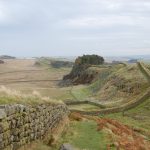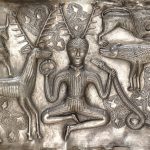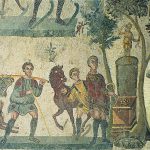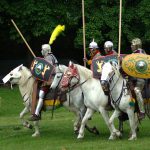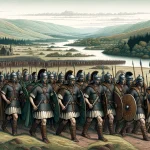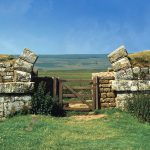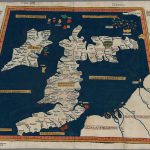Hadrian's Wall - Fort - Halton Chesters (Hunnum / Onnum)
Hadrian's Wall Fort
The Hadrianic Fort at Onnum – A dedicatory slab from the west gate of the fort tells us that the Sixth Legion were responsible for the initial building work, but unfortunately, does not give us the name of the original garrison. It is likely, but not proven, that the Hadrianic unit was a cohors quingenaria equitata, an auxiliary force containing a nominal five-hundred men, approximately half of which were mounted. Units of this type have been identified at many Wall forts, and would have been ideally placed here, the infantry contingent to guard the Fort and Wall, and the cavalry to patrol along Dere Street and the Devil’s Causeway to the north.
RIB 1429 - Building inscription of the Sixth Legion
The Sixth Legion Victrix Pia Fidelis built this.
P F FEC
No commentary.
RIB 1427 - Dedication-slab
For the Emperor Caesar Trajan Hadrian Augustus the Sixth Legion Victrix Pia Fidelis (built this) under Aulus Platorius Nepos, the emperor’s propraetorian legate.
AVG LEG VI V[...]
A PLATORIO N[...]
LEG AVG PR [...]
Nepos was governor a.d. 122 to about 126. The stone had weathered heavily before it fell.For dedications under Nepos see RIB 1634, 1637, 1638.The dative case, as being the norm, has been adopted here, since no case is preserved on the surviving portion of the stone.
Post-Hadrianic Alterations
At some time during the campaigns in Britain of emperor Septimius Severus between 208 and 211AD, an extension was added to the south west corner of the fort south of the wall, which housed a new bath-house and gave the fort an unusual, L-shaped plan. A large cross-hall was also added to the front of the Principia during the same period. The bath-house was later demolished and replaced with barrack-blocks and stables, probably during the reign of Constantius Chlorus at the end of the third century, when a new bath-house was built in the north-west corner of the fort. Bath-houses for the use of the soldiers were a usual feature of a permanent Roman fort, and they were built mainly outside the defences. The presence of a sequence of internal bath-houses here at Halton Chesters, though not unique, is nontheless quite remarkable.
Post-Hadrianic Building Inscriptions
RIB 1428 - Dedication-slab
The Second Legion Augusta built this.
II
AVG
F
No commentary.
RIB 1430 - Building inscription of the Sixth and Twentieth Legions
The Sixth Legion Victrix and the Twentieth Legion Valeria Victrix built this.
VIC ET
LEG [...]
V V
[...]EC ❦
No commentary.
RIB 1431 - Centurial stone of Hortensius Proculus
From the Twentieth Legion Valeria Victrix the century of Hortensius Proculus (built this).
[.] HORTENS
PROCVL
No commentary.
The Severan Cavalry Fort
A monumental slab roughly dateable to the third century was found at Halton Chesters bearing an inscription which links Ala Sabiniana with Onnum. The inscribed slab is now held at Trinity College, Cambridge. The alterations made to the fort in the Severan period were probably due to the replacing of the original garrison by Ala I Pannoniorum Sabiniana, the first cavalry regiment on the Wall, a five-hundred strong unit raised in Pannonia (modern Hungary). This unit would require more barracks and stables than the original part-mounted garrison, and the south-western extension of the defences more than likely served this purpose.
The Onnum Garrison
RIB 1433 - Fragmentary funerary inscription
…, a Norican tribesman, aged 30 Messorius Magnus, his brother, duplicarius of the Sabinian Cavalry Regiment, had this set up.
[...]IS NORICI AN XXX
[...]ESSORIVS MAGNVS
[...]RATER EIVS DVPL ALIAE
SABINIANAE
[...] C
Birley (Festschrift für R. Egger i 180) assigns this to the first half of the third century.A duplicarius, duplarius or duplaris was soldier receiving twice the basic rate of pay, in particular the second-in-command of a turma
The presence of Ala Primae Pannoniorum Sabiniana would also explain the new cross-hall fronting the Principia; this could have been used to assemble the officers when they were mounted on horseback, which would have been impossible in the Principia itself, where the days orders were traditionally issued. The The Notitia Dignitatum confirms that the same regiment was retained at Halton Chesters through to the beginning of the fifth century.
The Notitia Dignitatum Entry
The Gods of Roman Halton Chesters
Altarstones from Onnum
RIB 1423 - Fragmentary altar dedicated to Fortune
To the goddess Fortune ..
FORTV
NAE [..]
CVR[...]
HD[...]
No commentary.
RIB 1424 - Fragmentary altar dedicated to the Mother Goddesses
To the Mother Goddesses ..
[...]ATRIBV
[ ..] Ẹ [.]
No commentary.
RIB 1425 - Fragmentary altar dedicated to the Divinities of the Emperors
To the Divinities of the Emperors ..
AVGV[...]
[...]
No commentary.
There are only three altarstones from Halton Chesters, all of them damaged, and all are shown above. There are in addition three other stones which may be votive in nature (see below).
Other Possible Votive Stones from Onnum
RIB 1426 - Inscribed slab
The lightning of the gods.
DIVOM
For the details, and other instances of a bidental, see Antiq. J 66 (1986), 124-6.
RIB 1432 - Centurial stone of Saturninus
The century of Saturninus (built this).
No commentary.
RIB 1437 - Inscription
No translation
[...]NCTV[ ...]
No commentary.
Classical references to Onnum – ‘The Rock’
The name of the Halton Chesters fort first appears in the Notitia Dignitatum of the late-4th/early-5th centuries as Hunnum, between the entries for Uindobala (Rudchester, Northumberland) and Cilurno (Chesters, Northumberland). The wall fort is also mentioned in the The Ravenna Cosmography of the seventh century, appearing as Onno (R&C#146), again between the entries for Vindovala (Rudchester) and Celunno (Chesters).
Onnum Today
References for Onnvm/hunnvm
- Britannia xxxii (2001) p.328 & fig.8 p.329;
- Hadrian’s Wall Map and Guide by the Ordnance Survey (Southampton, 1989);
- Hadrian’s Wall in the Days of the Romans by Ronald Embleton and Frank Graham (Newcastle, 1984) pp.78-90;
- The Roman Inscriptions of Britain by R.G. Collingwood and R.P. Wright (Oxford 1965);
- Air Reconnaissance of North Britain by J.K. St. Joseph in J.R.S. xli (1951) pp.52-65; right (Oxford 1965); Air Reconnaissance of North Britain by J.K. St. Joseph in J.R.S. xli (1951) pp.52-65;
Roman Roads near Onnvm/hunnvm
Wall: W (6) to Cilvrnvm (Chesters, Northumberland) Dere Street: S (2.5) to Corstopitvm (Corbridge, Northumberland) Devil’s Causeway: NNE (29) to Learchild (Learchild, Northumberland) Dere Street: NNW (13) to Risingham (Risingham, Northumberland) Wall: E (7) to Vindobala (Rudchester, Northumberland) Wall: W (1) to Portgate
Sites near Hadrian's Wall - Fort - Halton Chesters (Hunnum / Onnum)
- Halton Chesters (Onnum) Bath House (0 km)
Bath House - Onnum (Halton Chesters) Vicus (0 km)
Vicus - Hadrian's Wall - Milecastle 21 - Down Hill (1 km)
Hadrian's Wall Milecastle - Hadrian's Wall - Milecastle 22 - Portgate (1 km)
Hadrian's Wall Milecastle - Portgate (1 km)
Hadrian's Wall Milecastle and Portgate - Hadrian's Wall - Milecastle 20 - Halton Shields (2 km)
Hadrian's Wall Milecastle - Hadrian's Wall - Milecastle 23 - Stanley (2 km)
Hadrian's Wall Milecastle - Hadrian's Wall - Milecastle 19 - Matfen Piers (4 km)
Hadrian's Wall Milecastle - Hadrian's Wall - Milecastle 24 - Wall Fell (4 km)
Hadrian's Wall Milecastle - Corbridge (Coriosopitum) Roman Fort and Town (4 km)
Roman Bridges, Stanegate Fort, Supply Depot, Temple Or Shrine, Vexillation Fort and Vicus
